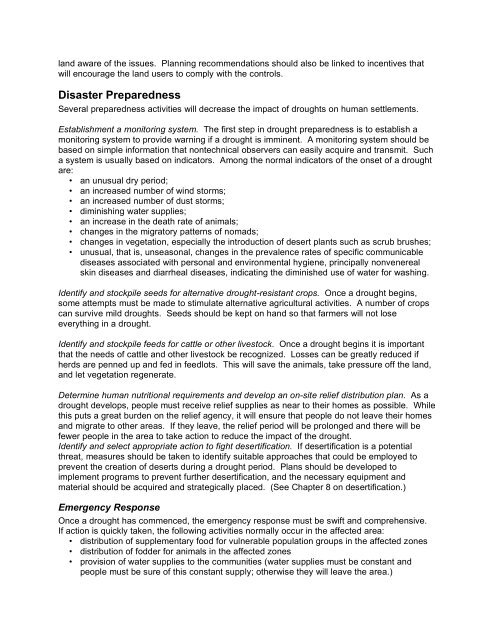Natural Hazards: Causes and Effects - Disaster Management Center ...
Natural Hazards: Causes and Effects - Disaster Management Center ...
Natural Hazards: Causes and Effects - Disaster Management Center ...
You also want an ePaper? Increase the reach of your titles
YUMPU automatically turns print PDFs into web optimized ePapers that Google loves.
l<strong>and</strong> aware of the issues. Planning recommendations should also be linked to incentives that<br />
will encourage the l<strong>and</strong> users to comply with the controls.<br />
<strong>Disaster</strong> Preparedness<br />
Several preparedness activities will decrease the impact of droughts on human settlements.<br />
Establishment a monitoring system. The first step in drought preparedness is to establish a<br />
monitoring system to provide warning if a drought is imminent. A monitoring system should be<br />
based on simple information that nontechnical observers can easily acquire <strong>and</strong> transmit. Such<br />
a system is usually based on indicators. Among the normal indicators of the onset of a drought<br />
are:<br />
• an unusual dry period;<br />
• an increased number of wind storms;<br />
• an increased number of dust storms;<br />
• diminishing water supplies;<br />
• an increase in the death rate of animals;<br />
• changes in the migratory patterns of nomads;<br />
• changes in vegetation, especially the introduction of desert plants such as scrub brushes;<br />
• unusual, that is, unseasonal, changes in the prevalence rates of specific communicable<br />
diseases associated with personal <strong>and</strong> environmental hygiene, principally nonvenereal<br />
skin diseases <strong>and</strong> diarrheal diseases, indicating the diminished use of water for washing.<br />
Identify <strong>and</strong> stockpile seeds for alternative drought-resistant crops. Once a drought begins,<br />
some attempts must be made to stimulate alternative agricultural activities. A number of crops<br />
can survive mild droughts. Seeds should be kept on h<strong>and</strong> so that farmers will not lose<br />
everything in a drought.<br />
Identify <strong>and</strong> stockpile feeds for cattle or other livestock. Once a drought begins it is important<br />
that the needs of cattle <strong>and</strong> other livestock be recognized. Losses can be greatly reduced if<br />
herds are penned up <strong>and</strong> fed in feedlots. This will save the animals, take pressure off the l<strong>and</strong>,<br />
<strong>and</strong> let vegetation regenerate.<br />
Determine human nutritional requirements <strong>and</strong> develop an on-site relief distribution plan. As a<br />
drought develops, people must receive relief supplies as near to their homes as possible. While<br />
this puts a great burden on the relief agency, it will ensure that people do not leave their homes<br />
<strong>and</strong> migrate to other areas. If they leave, the relief period will be prolonged <strong>and</strong> there will be<br />
fewer people in the area to take action to reduce the impact of the drought.<br />
Identify <strong>and</strong> select appropriate action to fight desertification. If desertification is a potential<br />
threat, measures should be taken to identify suitable approaches that could be employed to<br />
prevent the creation of deserts during a drought period. Plans should be developed to<br />
implement programs to prevent further desertification, <strong>and</strong> the necessary equipment <strong>and</strong><br />
material should be acquired <strong>and</strong> strategically placed. (See Chapter 8 on desertification.)<br />
Emergency Response<br />
Once a drought has commenced, the emergency response must be swift <strong>and</strong> comprehensive.<br />
If action is quickly taken, the following activities normally occur in the affected area:<br />
• distribution of supplementary food for vulnerable population groups in the affected zones<br />
• distribution of fodder for animals in the affected zones<br />
• provision of water supplies to the communities (water supplies must be constant <strong>and</strong><br />
people must be sure of this constant supply; otherwise they will leave the area.)








